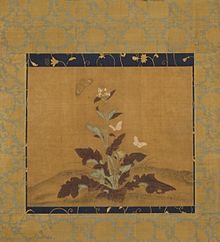
The turnip or white turnip is a root vegetable commonly grown in temperate climates worldwide for its white, fleshy taproot. Small, tender varieties are grown for human consumption, while larger varieties are grown as feed for livestock. The name turnip – used in many regions – may also include rutabaga, neep or swede.

Emmer wheat or hulled wheat is a type of awned wheat. Emmer is a tetraploid. The domesticated types are Triticum turgidum subsp. dicoccum and T. t. conv. durum. The wild plant is called T. t. subsp. dicoccoides. The principal difference between the wild and the domestic forms is that the ripened seed head of the wild plant shatters and scatters the seed onto the ground, while in the domesticated emmer, the seed head remains intact, thus making it easier for humans to harvest the grain.
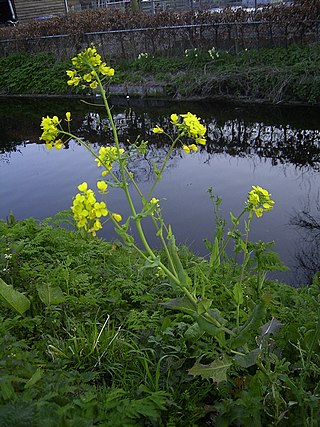
Brassica is a genus of plants in the cabbage and mustard family (Brassicaceae). The members of the genus are informally known as cruciferous vegetables, cabbages, mustard plants, or simply brassicas. Crops from this genus are sometimes called cole crops—derived from the Latin caulis, denoting the stem or stalk of a plant.

The radish is an edible root vegetable of the mustard family, Brassicaceae, that was domesticated in Asia prior to Roman times.

Beta vulgaris (beet) is a species of flowering plant in the subfamily Betoideae of the family Amaranthaceae. Economically, it is the most important crop of the large order Caryophyllales. It has several cultivar groups: the sugar beet, of greatest importance to produce table sugar; the root vegetable known as the beetroot or garden beet; the leaf vegetable known as chard or spinach beet or silverbeet; and mangelwurzel, which is a fodder crop. Three subspecies are typically recognised. All cultivars, despite their quite different morphologies, fall into the subspecies Beta vulgaris subsp. vulgaris. The wild ancestor of the cultivated beets is the sea beet.

Rapeseed, also known as oilseed rape, is a bright-yellow flowering member of the family Brassicaceae, cultivated mainly for its oil-rich seed, which naturally contains appreciable amounts of erucic acid. The term "canola" denotes a group of rapeseed cultivars that were bred to have very low levels of erucic acid and which are especially prized for use as human and animal food. Rapeseed is the third-largest source of vegetable oil and the second-largest source of protein meal in the world.

In agriculture, cover crops are plants that are planted to cover the soil rather than for the purpose of being harvested. Cover crops manage soil erosion, soil fertility, soil quality, water, weeds, pests, diseases, biodiversity and wildlife in an agroecosystem—an ecological system managed and shaped by humans. Cover crops can increase microbial activity in the soil, which has a positive effect on nitrogen availability, nitrogen uptake in target crops, and crop yields. Cover crops may be an off-season crop planted after harvesting the cash crop. Cover crops are nurse crops in that they increase the survival of the main crop being harvested, and are often grown over the winter. In the United States, cover cropping may cost as much as $35 per acre.
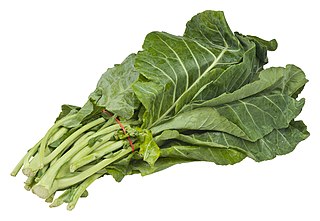
Collard is a group of loose-leafed cultivars of Brassica oleracea, the same species as many common vegetables including cabbage and broccoli. Part of the Acephala (kale) cultivar group, it is also classified as the variety B. oleracea var. viridis.

Chinese cabbage is either of two cultivar groups of leaf vegetables often used in Chinese cuisine: the Pekinensis Group and the Chinensis Group.

The founder crops or primary domesticates are a group of flowering plants that were domesticated by early farming communities in Southwest Asia and went on to form the basis of agricultural economies across Eurasia. As originally defined by Daniel Zohary and Maria Hopf, they consisted of three cereals, four pulses, and flax. Subsequent research has indicated that many other species could be considered founder crops. These species were amongst the first domesticated plants in the world.

Rhamphospermum nigrum, black mustard, is an annual plant cultivated for its dark-brown-to-black seeds, which are commonly used as a spice. It is native to cooler regions of North Africa, temperate regions of Europe, and parts of Asia.

Brassica rapa is a plant species growing in various widely cultivated forms including the turnip ; Komatsuna, napa cabbage, bomdong, bok choy, and rapini.

Brassica juncea, commonly brown mustard, Chinese mustard, Indian mustard, leaf mustard, Oriental mustard and vegetable mustard, is a species of mustard plant.

White mustard is an annual plant of the family Brassicaceae. It is sometimes also referred to as Brassica alba or B. hirta. Grown for its seeds, it is used to make the condiment mustard, as a fodder crop, or as a green manure. It is now widespread worldwide, although it probably originated in the Mediterranean region.
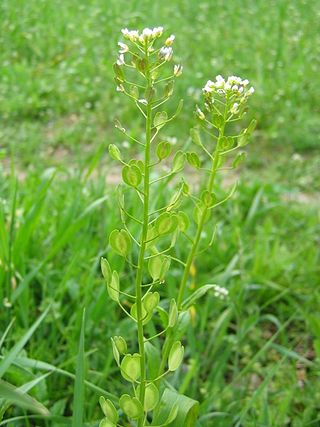
Thlaspi arvense, known by the common name field pennycress, is a flowering plant in the cabbage family Brassicaceae. It is native to Eurasia, and is a common weed throughout much of North America and its home.

Rhamphospermum arvense, the charlock mustard, field mustard, wild mustard, or just charlock, is an annual or winter annual plant in the family Brassicaceae. It is found in the fields of North Africa, Asia, Europe, and some other areas where it has been transported and naturalized. Pieris rapae, the small white butterfly, and Pieris napi, the green veined white butterfly, are significant consumers of charlock during their larval stages.

Napa cabbage is a type of Chinese cabbage originating near the Beijing region of China that is widely used in East Asian cuisine. Since the 20th century, it has also become a widespread crop in Europe, the Americas and Australia. In much of the world, it is referred to as "Chinese cabbage". In Australia it is sometimes referred to as "wombok".

A crop wild relative (CWR) is a wild plant closely related to a domesticated plant. It may be a wild ancestor of the domesticated (cultivated) plant or another closely related taxon.
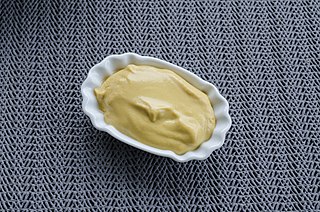
Mustard is a condiment made from the seeds of a mustard plant.
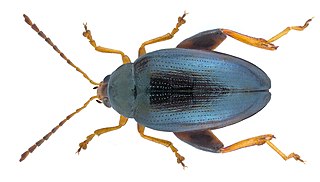
Psylliodes chrysocephala or Psylliodes chrysocephalus, commonly known as the cabbage-stem flea beetle, is a species of leaf beetle situated in the subfamily Galerucinae and the tribe Alticini.

